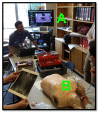How to Build a Low-Cost Video-Assisted Laryngoscopy Suite for Airway Management Training
- PMID: 37465653
- PMCID: PMC10332681
- DOI: 10.21980/J8C068
How to Build a Low-Cost Video-Assisted Laryngoscopy Suite for Airway Management Training
Abstract
Audience: This suite of borescope laryngoscopes is designed to instruct emergency medicine residents and sub-interns in video-assisted airway management.
Background: Skillful and confident airway management is one of the markers of a strong emergency medicine physician.1 Video-assisted airway management is a necessary skill, particularly in the setting of difficult airways and cervical spine immobilization.2,3 However, the idea of learning airway management "by doing" is high-risk and mistakes can have devastating implications on patient outcomes. Fortunately, high-fidelity medical simulation tools have been developed to address this dilemma, allowing a safe environment for providers to practice their airway management skills.4,5 These tools, while undeniably useful, are limited in their scope; they are often designed for clinical rather than educational use, and are proprietary and expensive.6,7Video laryngoscopes approved for patient use are difficult to implement widely in educational settings due to cost or because they cannot be removed from a designated area. Clinical video laryngoscopy suites typically cost 2,000 - 6,000 US dollars. Additionally, the video images can only be viewed on a local small screen rather than a television or projector. This means that the number of learners is limited by space around the small laryngoscope screen. These cost and space barriers may be especially pronounced in low resource or non-traditional learning environments.
Educational objectives: Using an anatomically accurate airway simulator, by the end of a 20-30-minute instructional session, learners should be able to: 1) Understand proper positioning and use the video laryngoscope with dexterity, 2) identify airway landmarks via the video screen, and 3) demonstrate ability to intubate a simulated airway.
Educational methods: We developed a low-cost borescope laryngoscope for airway simulation training. Using this device, learners should be able to identify airway landmarks and successfully intubate a simulated airway. The borescope laryngoscope, a novel device which employs the camera-end of a video borescope and a single-use VL blade, was used by learners during high-fidelity airway simulation. Learners were residents or medical students undergoing airway training in case-based simulation, or in airway-management procedure stations.
Research methods: The borescope laryngoscopes were used during dedicated airway training in place of their medical device counterparts. During case-based simulation sessions involving airway management, 32 residents and 20 medical students used the borescope laryngoscope. During dedicated airway management procedure stations, 12 medical students used the borescope laryngoscope. Learners were instructed to perform endotracheal intubation and fully visualize critical structures before passing the tube. Successful intubation was defined as the ability to pass the tube independently or with the help of the instructor.
Results: The borescope laryngoscope proved effective at video visualization of critical structures. Compared to official medical equipment, the VL borescope similarly allowed for visualization of a Cormack-Lehane Grade 1 view. Learners were able to visualize the airway anatomy and successfully pass the ET tube on each pass either independently or with the help of the instructor.
Discussion: The development of this airway-training tool was effective and less expensive than medical grade versions. Our group of learners successfully visualized essential anatomy and passed an endotracheal tube (ED tube) through the vocal cords. The borescope laryngoscope offers a comparable user experience at a much lower cost. The devices also allowed instructors to teach video laryngoscopy without depending on clinical equipment. Widespread use may allow for expansion of airway simulation training while maintaining a high-fidelity learner experience.
Topics: Video laryngoscopy, borescope, improvised equipment, airway training.
© 2023 Falk, et al.
Figures








Similar articles
-
An Innovative Inexpensive Portable Pulmonary Edema Intubation Simulator.J Educ Teach Emerg Med. 2020 Apr 15;5(2):I9-I20. doi: 10.21980/J8MM1R. eCollection 2020 Apr. J Educ Teach Emerg Med. 2020. PMID: 37465400 Free PMC article.
-
Modification of an Airway Training Mannequin to Teach Engagement of the Hyoepiglottic Ligament.J Educ Teach Emerg Med. 2024 Apr 30;9(2):I1-I6. doi: 10.21980/J8R06P. eCollection 2024 Apr. J Educ Teach Emerg Med. 2024. PMID: 38707943 Free PMC article.
-
Low Fidelity Trainer for Fiberoptic Scope Use in the Emergency Department.J Educ Teach Emerg Med. 2020 Jul 15;5(3):I1-I8. doi: 10.21980/J8764B. eCollection 2020 Jul. J Educ Teach Emerg Med. 2020. PMID: 37465221 Free PMC article.
-
CHALLENGES IN THE USE OF VIDEO LARYNGOSCOPES.Acta Clin Croat. 2016 Mar;55 Suppl 1:41-50. Acta Clin Croat. 2016. PMID: 27276771 Review.
-
The utilization of video laryngoscopy in nasotracheal intubation for oral and maxillofacial surgical procedures: a narrative review.J Dent Anesth Pain Med. 2024 Feb;24(1):1-17. doi: 10.17245/jdapm.2024.24.1.1. Epub 2024 Feb 1. J Dent Anesth Pain Med. 2024. PMID: 38362261 Free PMC article. Review.
Cited by
-
Assessing Otolaryngology Capacity in Sub-Saharan Africa: Flexible Laryngoscope Availability and Use.J Voice. 2025 Aug 12:S0892-1997(25)00302-9. doi: 10.1016/j.jvoice.2025.07.038. Online ahead of print. J Voice. 2025. PMID: 40803928
References
LinkOut - more resources
Full Text Sources
